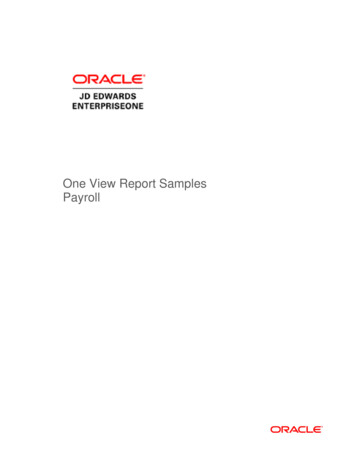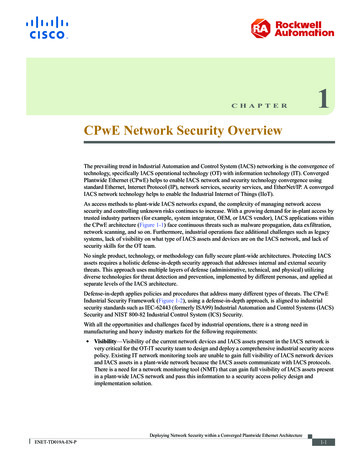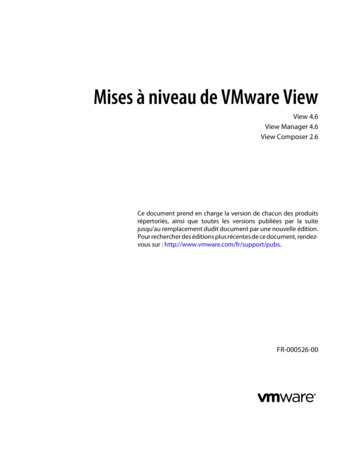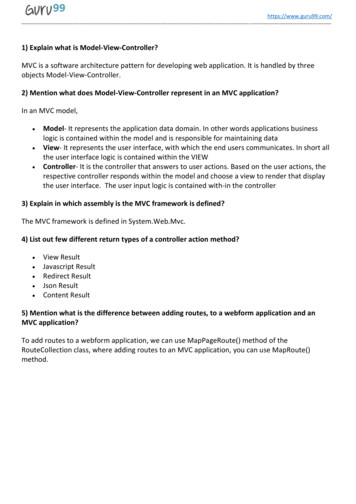
Transcription
Insiders View:Network SecurityDevicesDennis CoxCTO @ BreakingPoint Systems
Who am I? Chief Technology Officer - BreakingPoint Systems Director of Engineering - TippingPoint Engineering - Cisco Systems Operated an ISP
Today’s Talk Fact vs Fiction of today’s security devices How to approach testing the validity of claims Some simple math Example cases
Is it Hardware or Software? What type of box is it? Look at the mechanical design? Who’s runs the Hardware Team? What silicon is it using? How big is the company? Sub Contractor? Check for posts!
Hardware SecurityDevicesNot only does God play dice, but. he sometimes throwsthem where they cannot be seen - Stephen Hawking
Our Virtual rManagement BUSManagementProcessor
Ethernet nagement BUSManagementProcessor Who is the vendor? ESIC will get you true loveWhat are the specs?What revision is the chip?(A0 is sweet, sweet love)Everybody uses the samedriver - audit the drivercode
Ethernet FramesFrames Per SecMegabits Per 064 512 1518645121518
Content Addressable r Same Questions Overflow the CAMManagement BUSManagementProcessorSemi ProgrammableSuper Fast, Little FlexibilityCisco Switches are CAMBased - accessible viaSNMP
Field Programmable Gate ArrayEthernetMACFPGACAMEthernetMACNetworkProcessor Questions don’t apply Attack State Machine andParsing Engine Abnormal QA cycleManagement BUSManagementProcessorVery ProgrammableIt’s a Processor (custom)Some Security Guy - Some Software Engineer - Some RequirementsDocuments - SomeDesign Engineer
Network essorManagement BUSManagementProcessor Questions don’t apply It’s a fix field pattern parserProgrammability is basedon the VendorState, State and more StateMuch stronger on bugsReally bad on memoryUse it’s abuse of memoryto your advantage
Management ProcessorEthernetMACFPGACAM Just your average, ordinarychip If you cause themanagement interface tobe busy, do packets slowdown? Really bad on memoryEthernetMACNetworkProcessorManagement BUSManagementProcessorUse it’s abuse of memoryto your advantage
Exception Processing Exception processing or “SlowPath” Most complex devices have one If you can get to the Management Processor viaException you can root the box or denial ofservice the boxThe more complex the request, the betterchance it goes thereTip: If a device supports encryption, exceptionhandling is constant.You can DDoS with a fewKbytes of traffic.
nagement BUSManagementProcessor Multiple BUSes sometimes Some buses can’t handle interleavedpackets Could you force interleaving ofpackets? Buses use wimpy identifiers - can youmodify that identifier? A bus has two elements: MaxPerformance, Max # of FramesIf they are interconnected doesn’tmatter still weakest link the chain Max Frame Size Max Frames Max Performance
Bus MathBus andFrequencyPeak 32 bitTransfer RatePeak 64 bitTransfer RateReality33-MHz PCI133 MB/sec266 MB/sec972 Mb/s66-MHz PCI266 MB/sec532 MB/secN/A100-MHz PCI-XN/A800 MB/sec2 Gb/s133-MHz PCI-XN/A1 GB/secN/AAGP8X2.1 GB/secN/A* Parts of the data are from Dell and Intel’s website
Software SecurityDevicesA man’s got to know his limitations.Dirty Harry
Connection Math 70 percent of traffic is TCP (location matters)Average TCP packet size 512 bytes (99% 70 bytes and 1400)1 Gigabit at 512 bytes equals 244k connections (1,000,000,000 / 8) / 512 244k Gigabit Ethernet wires can have 1.4 million connections persecond happening at any moment in timeTCP setup requires 3 packets under 70 bytes (generally)which means.* The stats change per about every 9 -12 months. These stats are from November 2004. Source: More sites that I can list(Cable Companies, Telcos, Major Universities and Corporations)
Software Interrupt Stats A super high end Ethernet Card (Intel Pro/1000 Server) Receive 680,000 pps Transmit 840,000 pps The above can only handle half-duplex, letalone full-duplex Conclusion: HardwareSystems don’t sufferthis fate (depending on the hardware system)
Software Performance If your using a “Dude it’s a Dell”. Your at 761M divided by 2 roughly . 380 Megabits per second
Software Boxes We already know - limited by BUS We already know - limited by Interrupts What else do we need to know?
Software Optimizations Buffers are the key Buffers are generally not malloc’d Having too many buffers causes latency due toslow access of the buffers Too SlowBuffers are set to max packet size If the device supports jumbo frames that’s 9ksize.
Buffers Continued Fragmentation and TCP Reassembly take upbuffers (64k IP ? TCP) Generally an additional pool of memory Attacks over time based on # of buffers - orworse yet they drop when buffers are full! Regular Expressions or Protocol Decoders They take up buffers!
Finding the kill spot Something’s cost more than others What costs the Box the most? Latency is the easiest way. The secret is the .
Example - ISS First Questions: What type of box is it?Look at the mechanical design?Who’s runs the Hardware Team?Answers: G1000 has Two Gigabit Ethernet Ports *Repackaged “Dell” Server with a logo on itNobody runs hardware - they don’t have a team *** Information can be found at entiaGSeries Datasheet.pdf
Example - ISS They use a PCI Bus on that Dell Platform Bus limited to 528 Mbits/s full duplex (472 due to overhead)Using Software - so Interrupts come into play 368 Mbits/s full duplex (64 byte packets)Using Two Ethernet Controllers Double the Interrupt fun! 184 Mbits/sRequires at least double buffering Ethernet 1 to PC to Ethernet 2A Dell Server costs 3k (US) max ISS charges 36k (US) for the product
Example - ISS Second Questions: What is the rated max concurrent sessions?How does it handle buffers?Answers: Rated 1,000,000 Concurrent SessionsTCP Reassembly and Flow Reassembly supportedJumbo Frames Supported
Example ISS (Flow Reassembly TCP Reassembly MaxPacket Size) * Max Sessions (64k 9k 9k) 82k * 1,000,000 82,000,000,000 82 Gigabytes of memory Max addressable memory - 4 Gigabytes 1,000,000 sessions concurrent can beoverflowed on a single Ethernet Wire
ISS - Knowing that It most likely can’t hit 1 Gigabit per second since it wouldget killed on small packets It can’t handle 1 Million connections Can’t address that much memoryToo many buffer copiesNo memory for anything else!Even if they could they need to handle more (1.48M)Homework: Narrow done which area of memory is thesmallest - send partial attack thru that area of memory - fillit up then send the rest of the attack
Juniper Inspection Never saw one before up close Got it on eBay IDP-50 (new!) 1U PC [Pentinum 4 2.8 Ghz] [ATI RAGE] Linux Kernel 2.4.31 Using Intel e1000 cards [w/ Silicom Bypass]
Juniper Inspection.2 IDP 10, 50, 100, 200, 500, 600C/600F, 1000,1100C, 1100CF . same box? e1000 cards set to 4096 descriptors Went from 3.1 to latest release (driverschanged multiple times) They are secure enough in their manhood root
Juniper Inspection.3 Requires management server - loaded it onthe box itselfand sctop are your friends scio/usr/idp/device/. scio - IO control (set/get all sorts of cmds)sctop - Monitor everything [/usr/idp/device/bin] - attach and watch Box was too loud - what can I do aboutthat?
Virtualize
False Positives Mythical to me Two out of the box IP: Microsoft IGMPv3 DOS (uh?) SSH: PuTTY SSH2 MSG DEBUGOverflow (dropped!!!)
Juniper Sig Dive The signature constructs [context regex] IGMP Packet with IP Options Client to Server using SSH looking for \(SSH.2\0.PUTTY\].* Then Server to Client in a packet looking for ([ \00]. .[ \00]. .[\040-\0377]).\x04\x.[\0200\0377].* SSH
Juniper Thoughts Now I’m curious - if it’s all regex. RECURSION - let’s see how to handles it [dig dig dig dig dig dig dig] hmmm - what’s this?
./scio counter get flow
./scio const list
How did it handlestrikes?[0 out of 4] Backdoors Network Worms [3 out of 6][21 out of 155] Exploits[5 out of 78] Recon[33 out of 37] Hostile Denial of Service [1 out of 20]
Score21%
Example - Juniper Juniper Filter HTTP (“.*/cvsweb\.cgi/.*;.*”) Running on a 1.5 GHZ G4 using PCRE v6.4 Standard run (after initial) (100 bytes) Match: 66 usecs 15,151 PPS Miss: 4 usecs 250,000 PPS
Example - Juniper 2 Increase Data to 1500 bytes Match: 179 usecs 5,586 pps Miss: 191 usecs 5,235 pps Multiple Packets (15k) Miss: 1452 usecs* 688 pps
Build your own 200/600 Buy one Super Microboard ./scio const -s s0:reass setsc tcp max packet mem kb 0x100000 [insert]Install two XEON 2.8 CPU’sInstall 2 Gigabytes of memoryInstall Silicom Ethernet cards (e1000)./scio const -s s0:reass setsc tcp max flow mem kb 0x4000 [insert]
Example - TopLayer “Leader of Intrusion Prevention” 4.4 Gbs raw firewall throughput 2.0 Gbs rated firewall throughput 50k new sessions per second 50k sessions tear-down per second 1 million Concurrent Sessions 1.5 million SYN Flood DOS Protection Rate* Reference TopLayer Website
Math, Math, Math 50,000 is the max session setup 50,000 Connections * 64 Bytes Can only achieve 3.2 Mbits per second of newtraffic (being conservative) Real world testing shows that a TopLayer boxcan handle 2.5 Mbits of traffic before beingDDoS itself Math proved it out! Now checkout a Netscreenbox!
Device Discovery Most inline devices modify packets Some change TTL’s Others reorder TCP Packets Did you know some devices even set uniquevalues in packets that come there way? Can you figure out what device does what? Example: TopLayer sets TTL to 255 and TCPOptions are changed to MSS 1460
Remember! Somewhere on every device the box truststhe packet in some way Find that location and you’ll get your exploit ISS, Netscreen and Toplayer are justexamples - no offense to those poorbastards Every box has it’s Breaking Point
Questions?Dennis Coxdcox@bpointsys.com
Exception Processing Exception processing or "SlowPath" Most complex devices have one The more complex the request, the better chance it goes there If you can get to the Management Processor via Exception you can root the box or denial of service the box Tip: If a device supports encryption, exception handling is constant. You can DDoS with a few










